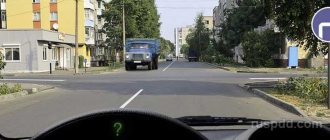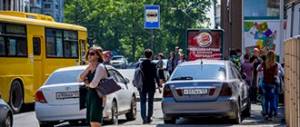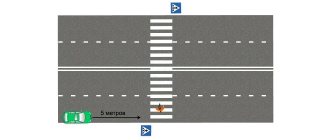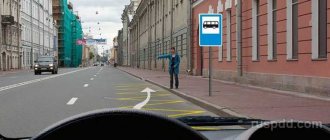Due to amendments to the traffic rules, traffic rules will soon include a ban on driving into traffic islands. The innovations are part of a large-scale project developed by the Ministry of Transport. At the moment, the amendments are at the stage of legal and anti-corruption examination. This innovation is part of a package of changes, which also includes tinting rules and speed limits. Let's figure out what the driver will face when stopping on such an island.
An advantageous offer from the partners of our portal - Terem Loan! Apply for a loan in the amount of up to 30 thousand rubles for a period of up to 30 days.
100% approval!
Get money
What is a safety island and what are they?
According to the rules, a traffic island is a part of the road; it separates traffic lanes or, conversely, indicates their merging. Sometimes a traffic island is part of a pedestrian crossing. A pedestrian stops there to cross the road.
Islands are marked with markings and borders.
Island with markings. There are three options for marking an island using markings: to separate opposite lanes, separate and merge two streams of cars in one direction.
Island border. With its help, road services help pedestrians cross a multi-lane road.
Marking 1.16.1 separates opposite lanes. Source: rg.ru
Markup 1.16.2 separates traffic flows
Markup 1.16.3 merges two streams into one
Yellow posts stand on a hill with a curb - this is a safety island
Parking in front of the intersection
In other cases, stopping and parking on a traffic island is punished less severely. If the car stops in the neutral zone before crossing roadways, but not within the intersection, then evacuation of the car is not provided, but this act will result in a fine of 500 rubles. This fine is issued not for parking, but for violating the marking requirements. When driving to the island, the driver crossed a solid line, which is punishable by punishment.
Question answer
Where in Moscow are cameras for recording traffic violations?
By the way, a traffic island is not considered a shoulder, and if sign 3.27 “Stopping is prohibited” is not installed in front of it, then cars can be on it. In cities, the coverage area of sign 3.27 applies only to the part of the street where it is located. The traffic island is usually located in the middle of the roadway and does not fall within the area of the sign.
Thus, when stopping on a traffic island for a short time, a severe fine and evacuation can be avoided, unless, of course, there are yellow marking lines there.
The most ambiguous parking option is parking within an island, which is located at a point where traffic flows in the same direction separate, but not at an intersection.
Often in such places there are cameras recording violations that fine drivers for turning from the middle rows. In this case, a fine is applied under Article 12.16 of the Code of Administrative Offenses of the Russian Federation for violation of marking requirements. Parking on the traffic island is not prohibited in this case either, although you will have to pay a fine of 500 rubles to get there.
In this case, evacuation of the car is not provided if there is no sign 3.27 in front of such an island or there are no yellow marking lines.
Is it possible to avoid paying a fine for driving on an island?
It happens that the video recording camera made a mistake and incorrectly recorded a violation. This happens with Strelka-ST camera models. To give the driver a better chance of challenging the fine, it is better to use a DVR. Read about how to challenge fines from the State Traffic Safety Inspectorate, MADI or AMPP in our other article.
If the driver does not agree with the inspector’s decision, he can appeal it within 10 days. If the traffic police cancels the fine, you won’t have to pay.
In all other cases, this will have to be done, otherwise 70 days after the violation the fine will be handed over to the bailiffs. After this, the bailiffs will begin enforcement proceedings and assign an enforcement fee - 1000 rubles, or 7% of the fine. If you continue to not pay, the case will be taken to court and the money will be withdrawn from your bank account.
What to do if the case is already with the bailiffs or the money was withdrawn twice, read our analysis about the FSSP.
Is it possible to park on a traffic island?
Bottom line. In big cities there are “safety islands” designed for pedestrians who did not cross the road in time. However, drivers ignore the rules and leave their cars in this area.
The center of the island on the roadway must be in line with the marking line separating traffic flows in opposite directions.
No! Stopping in this place is prohibited, since this marking is designed for pedestrians who did not have time to leave the road section at the traffic light, which gave the right of way to the car.
How to receive notifications on time to pay a fine at a discount
It happens that due to a large influx of visitors, electronic services work with malfunctions or a long delay. This was the case when the president signed a decree on child benefits in June 2021. Parents began to process payments through government resources and overloaded the server. There was no access to other services, such as checking fines, for a long time.
In order not to depend on force majeure, subscribe to the traffic police fines notifications. The service takes information directly from the GIS GMP database. All duties, fines and taxes in favor of the state pass through it.
Normative base
All issues related to traffic islands are regulated. The interpretation of this concept can be studied in the Traffic Regulations, specifically in the “Definitions” section, paragraph 2.42. Appendix 2 of the Rules describes marking options. The islands are a geometric figure whose sides are a solid line.
There are also certain rules in these areas. Violation of them entails administrative liability. This issue is regulated by the Code of Administrative Offenses, in particular, by Articles 12.16 and 12.19.
Remember
- A safety island is made by markings or by raising it above the road.
- The island is needed to separate traffic flows and protect pedestrians on the wide road.
- The fine for crossing or turning around on an island is 500 rubles.
- The fine for stopping or parking on an island is 1,000 rubles.
- If the fine is not paid within 70 days, the fine will be handed over to the bailiffs, who will write off the amount of the fine from the account.
- To receive notifications about fines on time and pay fines at a discount, subscribe to notifications on the Traffic Police Fines website.
Author: Evgeny Lesnov
When can you get a fine for a traffic island?
Many drivers still think that stopping or parking on a traffic island is not a violation of traffic rules. At the same time, visiting such “islands” falls under various articles of the Administrative Code. If the car stops at the markings, this is a violation of the rules for stopping and parking vehicles. And if a car drives over it, this is a violation of the rules for location on the roadway or a violation of the marking rules.
A fine for crossing a traffic island is imposed if you decide to park your car in such an area or get lost and decide to stop and clarify the route. If an accident occurs in which no one was injured, parking on such markings is also prohibited. The car must be removed as soon as possible, either on its own or with the help of a tow truck.
If the reason for the stop was forced measures or extreme necessity, for example, a car breakdown, driving to the markings is considered acceptable. At the same time, drivers very often complain that with the development of photo and video recording of traffic violations, they increasingly began to receive fines for repairing their car or waiting for help on such “islands.” Many lawyers note that when providing evidence of emergency parking, the resulting fine is easily disputed and canceled.
In a situation where the driver is forced to avoid an accident according to the markings, especially when other opportunities to get to the desired exit are blocked, crossing the traffic island is not considered a violation. If the responsible persons still did not take the circumstances into account and sent a fine, such cases can always be challenged in court.
What it is? Definition
We will try not to sprinkle in legal terminology (although we absolutely cannot do without it), but to explain everything in a simple language that is accessible to most.
A traffic island is a place on a median or roadway in the area of a pedestrian crossing where pedestrians can wait to cross the road further.
This may be an area marked only by markings, or both markings and a curb (raised traffic island). In addition, there is GOST R 52766-2007 (regulates elements of the development of public roads), which sets separate standards. We'll talk about them in more detail below.
Let’s immediately make a reservation that we will not consider raised islands, and especially transitions in places equipped with fencing. Few people would think of driving or parking there. Our further task is to deal with the islands, indicated only by markings.
Stopping in front of a zebra crossing
There are several types of traffic islands. They are created in places where traffic flows in the same direction are separated, in front of pedestrian crossings or in front of intersections. Safety zones in front of pedestrian crossings are placed in order to move traffic lanes as far as possible to the sides and provide a place for people who do not have time to cross the road where they can wait out the red light and wait for the green one.
Parking on the traffic island in front of a zebra crossing is strictly prohibited. A car left there will block the view of both pedestrians and vehicle drivers. As a result, dangerous situations on the road may arise. The rules prohibit stopping cars within 10 meters of the crossing. Motorists who violate this requirement will face punishment under Article 12.19 of the Code of Administrative Offenses of the Russian Federation. For this act a fine of 1000 rubles is imposed. In special cases, the traffic island is marked with yellow markings prohibiting stopping and parking. If it is applied, the vehicle may be towed.
What does the markup look like for 1.16.1 – 1.16.3? Photo of the safety triangle
It would seem that what could be simpler - take a photograph of the traffic island and provide the reader with its appearance? However, if everything were so simple, the article would end there. But no! The difficulties are just beginning, and it is in the appearance of the markup (or rather in its interpretation) that the main problems, which will be discussed further, lie.
We'll have to turn to GOSTs again. The already mentioned GOST R 52766-2007, in turn, refers to another regulatory act regulating road marking standards. Until recently, this was GOST R 51256–2011, but has now been replaced by GOST R 51256–2018.
The safety island designated in these standards is visually different. Let's compare:
| Number | GOST R 51256 – 2011 | GOST R 51256 – 2018 |
| 1.16.1 | ||
| 1.16.2 | ||
| 1.16.3 |
The numbering of these points is the same in both GOSTs. Is the appearance of the islets different? If you look at the photo, it seems that yes, and quite strongly. But in fact, everything is somewhat more complicated. This requires a separate explanation.
What is the difference between markup, and what problems are associated with it?
Under the old GOST, the problem was associated with penalties. There are no specific traffic rules prohibiting driving onto a traffic island. However, motorists received fines. The reasoning was at the intersection of the continuous marking 1.1, which borders the island.
Drivers often insisted that the indicated line was not continuous, but was only part of the overall marking. It was often possible to convince the courts that no violation had occurred.
Now, according to the new GOST, continuous markings in the drawings are completely absent. It may seem that the dispute has been resolved in favor of the traffic participants, but this is not so - not only has the ban not been lifted, it has become even more obvious!
Let's return to GOST R 52766-2007. Now it states that clause 1.16.1 (according to GOST R 51256 - 2018) is the marking of the area of the traffic island, i.e. marking the interior. It is separately indicated that its boundaries are indicated in accordance with clause 1.1 of GOST R 51256 - 2018 - with a solid inclined line, i.e. it is directly stated that the border of the island is continuous.
Marking illustration 1.1 according to GOST R 51256 – 2018
With difficulty, we sorted out the first problem. Now it is clearly indicated that travel through the traffic island is the intersection of a single continuous road. But that is not all.
Definition in traffic rules
According to traffic regulations, a safety island is a designated area on the roadway or dividing strip adjacent to a pedestrian crossing. One of its main tasks is to provide pedestrians with the opportunity to wait for traffic to decrease, for a gap to appear between moving vehicles, and to cross the road safely.
To create the boundaries of the island, markings on the asphalt or a curb raised above the surface can be used. Occasionally, such elements on the road may have fences or columns.
What does it look like and the requirements according to GOST
The basic requirements for the creation and appearance of this element are contained in GOST R 52766-2007 and GOST 51256-018. Excerpts from these documents read:
- the minimum permissible width is 150 cm (at the same level as the minimum width of the pedestrian crossing), and in conditions of busy city traffic - 200 cm. To increase the storage capacity, the safety zone is slightly shifted relative to the zebra crossing;
- installation location - a roadway with a traffic intensity of at least 400 cars per hour;
- the minimum distance from the zone boundary to the edge of the roadside is 7.5 meters, a shorter distance will lead to regular congestion;
- the zone boundary is indicated by a solid white line 10 or 15 cm wide;
- the inner part is marked in the form of inclined, solid, white lines, 40 cm wide and located at an angle of 45 degrees to the dividing strip. It is allowed to install curbs along the border of the island and raise it above the rest of the roadway.
What is the operating principle
The main, but not the only task of the island is to create a safe zone on a roadway with heavy traffic, where pedestrians can wait for a gap in the flow and cross the road. The safety island also has other tasks:
- Traffic calming, which is achieved by narrowing the roadway. Thanks to this change in trajectory, the average flow speed is reduced, and the safety of unregulated pedestrian crossings is increased.
- Separation of flows moving in different directions. For this, lines 1.16.1 are used (straight, parallel, of different lengths).
- Separation of flows of one direction. To perform this function, lines 1.16.2 are used (broken, with vertices directed towards the convergence of flows).
- To indicate the confluence of one-way flow. Lines 1.16.3 are used (broken, with vertices directed in the opposite direction from the approach).
Requirements for a safety island according to GOST
A few more standards. According to GOST R 52766-2007, the following standards exist:
- The flow of vehicles in places where islands are established is at least 400 units/hour.
- The width of the roadway from the edge of the island to the nearest shoulder of the roadway is at least 7.5 m.
- The island cannot be smaller than the width of the pedestrian crossing, and its minimum length is 1.5 m.
GOST R 51256 – 2021 also has its own requirements for marking:
- Line 1.1 “Solid”. This is a white continuous line 0.10 or 0.15 m wide.
- Marking 1.16.1 “Internal marking of the island.” White slanted solid stripes parallel to each other. The width of each strip (a) is 0.40 m. The distance between the strips (c) is 1.2 m. The angle of inclination of the axis of these strips relative to the solid axis (α) is 45˚.
Illustration of marking 1.16.1 in GOST R 51256 – 2018
The lane parameters in paragraphs 1.16.2 and 1.16.3 correspond to the standards of line 1.16.1.











